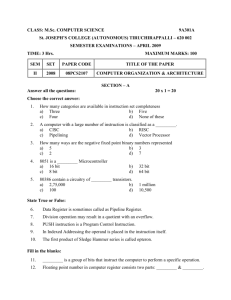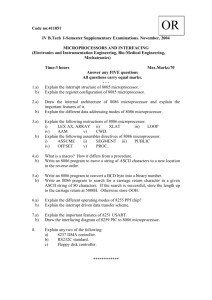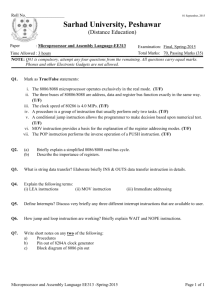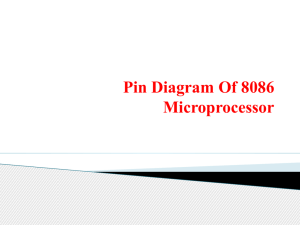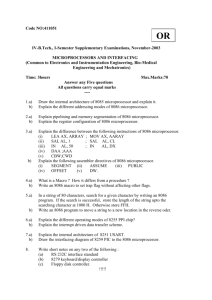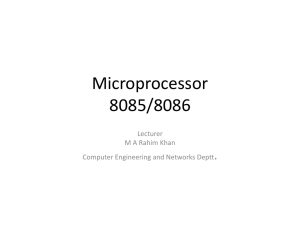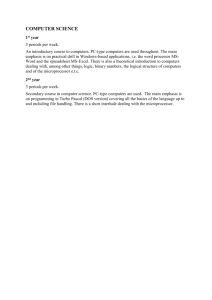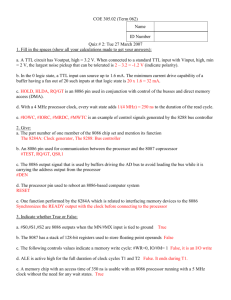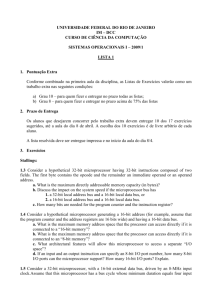Homework #1
advertisement
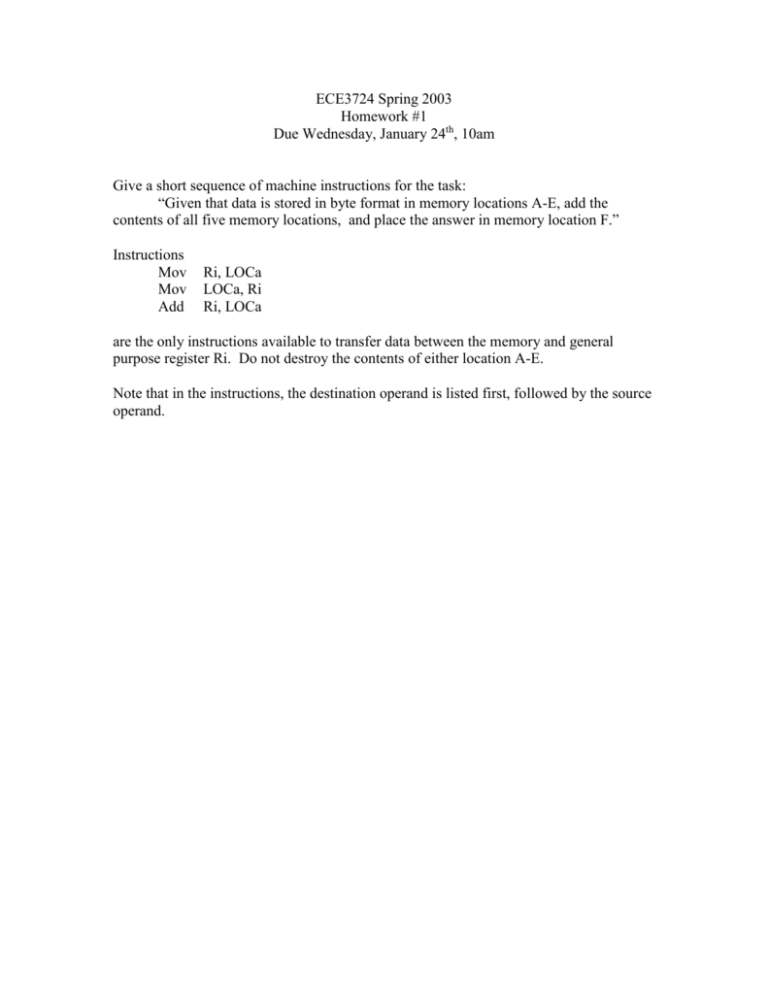
ECE3724 Spring 2003 Homework #1 Due Wednesday, January 24th, 10am Give a short sequence of machine instructions for the task: “Given that data is stored in byte format in memory locations A-E, add the contents of all five memory locations, and place the answer in memory location F.” Instructions Mov Mov Add Ri, LOCa LOCa, Ri Ri, LOCa are the only instructions available to transfer data between the memory and general purpose register Ri. Do not destroy the contents of either location A-E. Note that in the instructions, the destination operand is listed first, followed by the source operand. Uffenbeck Book Homework #1 Chapter 1 - Self test 1-8,11, 13 -17, 19-21 Analysis and Design 1.2 -1.4, 1.9-1.11 1. The three main parts of a stored program computer are__________, _________, and __________. 2. Stored program computers repeatedly follow the sequence ___________ and ____________. 3. When data flows from memory into the processor, a _________ ________ cycle is said to occur. 4. Under what conditions can the fetch and execute cycles of a computer overlap? 5. Under what conditions can the instruction decode and execute cycles of a computer overlap? 6. List the three buses of a stored program computer. _________, _____________, and ___________ 7. 80x86 processors organize their memory into banks, with each bank _________ bits wide. 8. An 80x86 processor with a 20-bit address bus could access __________ bytes of memory. 11. A microprocessor with built-in I/O and memory is called a ____________________. 13. Which of the following are characteristic of a CISC? List all that apply. a) All instructions execute in a single clock cycle. b) A small number of general purpose processor registers. c) A large number of instructions with many different addressing modes. d) Each instruction has the same length 14. A DSP is: a) an analog microprocessor b) a microprocessor optimized to perform repetitive math operations c) a microprocessor designed to process analog signals that have been converted to digital form. d) both (b) and (c) 15. Does the 8086 microprocessor have an internal data bus width that matches the external data bus widths? _________ If not what are the two bus widths? Internal _________, External ________ ** 16. When operated in Real Mode, an 80x86 microprocessor appears to be an ________ processor. 17. **How wide are the 8086 microprocessor internal data registers? _____________ 18. When using a cache memory, the processor first searches the cache for necessary data or the next program instruction, if found a _________ is said to occur. 19. Does the 8086 have cache memory? (Yes/No) _______________ 20. Which of the following 80x86 microprocessors have more than one instruction decoder? 21. The external data bus of the processor is also known as the ____________ __________ _______. Analysis and Design Questions 1.2) The 8086 microprocessor has a 16-bit data bus. Its memory is organized into ______banks, each ______-bits wide. 1.3) A microprocessor with a 24-bit address bus could access ___________ of memory. 1.4) Explain the difference between a memory read cycle and an I/O read cycle. In which direction does data flow for these cycles? 1.9) Intel microprocessors organize their memory into 8-bit wide banks. The 16-bit 80286, for example, requires 2 such banks. Typically these banks are built using 4MB or 8MB SIMMs (single in-line memory modules). For each of the following processors determine the minimum number or 4MB SIMMs required, the resulting amount of memory and the maximum amount of memory possible. The 80286 case is given as an example (assume byte w Minimum number of Microprocessor SIMMs 80286 80386DX 80386SX 80486DX Pentium 2 Total memory capacity for these SIMMs (at 4MB each) 8MB maximum memory capacity for this processor 16MB 1.10)Explain why each of the following microprocessor features affect (or do not affect) the processing rate of the chip. a) clock frequency b) data bus width c) address bus width d) internal cache memory e) coprocessor (internal or external) 1.11)Beginning with the 386, the 80x86 processors supported three different operating modes. Give a brief explanation of each. Real Mode Protected Mode Virtual 8086 Mode
